





Your practice management software is full of critical data that could help you make better decisions and be more productive and profitable — if you knew how to find and use it. Jarvis Analytics unleashes dark data deep inside your group practice or DSO so you can track and view everything in real-time, find hidden production opportunities and drive better decisions. With Jarvis Analytics, your data becomes the engine for your growth.
Schedule a Demo at: JarvisAnalytics.com
MANAGING EDITOR
Graham Garrison ggarrison@sharemovingmedia.com
SENIOR EDITOR
Daniel Beaird dbeaird@sharemovingmedia.com
ASSOCIATE EDITOR Pete Mercer pmercer@sharemovingmedia.com
CIRCULATION Laura Gantert lgantert@sharemovingmedia.com
ART DIRECTOR Brent Cashman bcashman@sharemovingmedia.com
EDITORIAL BOARD
Dr. Eric Roman, DEO Rachel Shipley, DEO Hilda Gonzalez, DEO
PUBLISHER Jake Puhl jacobpuhl@deodentalgroup.com
VP OF MEDIA SALES Amy Cochran acochran@sharemovingmedia.com 770.263.5279
DEO Magazine is published six times a year by DEO Dental Media LLC, 501 Congress Avenue, Suite 150, Austin, TX, 78701. Copyright 2022 by DEO Dental Media LLC All rights reserved.
POSTMASTER: Send address changes to info@dentalgrouppractice.com.
If you would like to subscribe or notify us of address changes, please contact us at the above numbers or address.
The opinions expressed in this publication are those of the authors. They do not purport to reflect the opinions or views of the Dentist Entrepreneur Organization, LLC, DEO Dental Media, LLC, or DEO Magazine. Also, the information in this publication is meant to give readers general information that they may find of interest. It is not intended to substitute for compliance, audit, advisory, tax, legal, or other professional advice. Readers should consult with appropriate professionals before making a decision to use any of the material presented in this publication.
Please note: The acceptance of advertising or products mentioned by contributing authors does not constitute endorsement by the publishers. Publishers cannot accept responsibility for the correctness of an opinion expressed by contributing authors.
dentalgrouppractice.com
How one industry leader is on a mission to make
dental finance topics more digestible.
> pg 28
Closing Out the Year Strong .....2
Tackling the Dentistry Staffing Shortage............................. 4
Loveland Dental Group Spreads Love in the Tar Heel State Family group practice grows through fun culture, cutting-edge technology ........... 6
Think Like a Shark Want to maintain profitability and momentum amid a disruptive market? You need to have a Shark-like mentality..... 10
Getting a more accurate depiction of your business’s financial position 14
How to spark your next big idea .................. 16
How labor management oversight leads to a healthier bottom line 20

Finding the right CFO for your organization starts with understanding the skill sets and experience of prospective candidates 24
Choosing the right strategy for growing your dental group .......................... 36
Tips and tricks for DSOs looking to increase efficiency 40
The keys to optimizing revenue cycle management for your dental group ............ 42
Choosing a growth strategy that works for your unique organization. 46
Why finding the right banking partner is critical to securing the kind of debt financing that your practice needs to grow 50
Three trends to watch, and how revenue growth is a team goal 52
Banks should be a partner to dental groups as they grow 56
Evolving the strategy and messaging are key to building strong core values through growth 60
Healthy Net Production to Collection Ratio 64
Our DEO Partners and Leadership Team just concluded our Annual Reset where we followed the same process our Implementer’s take members through on their DEO MAP Journey. This created the opportunity for discussion, collaboration, and problem solving as we reflected on this past year. We came away with increased clarity on our company vision and plan along with confidence and alignment within our team.
When like-minded people gather with the goal of improving outcomes for all, good things are bound to happen. Case in point – this month’s cover story on the Dental Finance Forum. Ken Kaufman, President & CFO of Nuvia Dental Implant Centers, started the Dental Finance Forum a couple of years ago because he wanted to discuss ideas and work through common challenges with other finance leaders in the dental space.
“We’re all trying to solve things that are hard to solve because dentistry is a con solidating industry,” Kaufman said. The first Dental Finance Forum meeting consisted of six people. Today, the Forum has over 100 members, with no signs of slowing down.
Along with Kaufman, this issue features several of the top CFOs in the industry who share their best practices and insights:
> In “The Changing Role of a CFO in a Growing DSO,” Corus Orthodontists CFO Nick Korhonen writes that finding the right CFO for your organization starts with understanding the skill sets and experience of prospective candidates.
> Ed Dallwein, CFO of Riccobene Associates Family Dentistry, has a few tips on how to spark your next big idea related to the financial success of your organization.
> Hollie Williams, CFO at Rodeo Dental in Dallas-Forth Worth, Texas, and Mike Yates, CFO at Lumio Dental in Tulsa, Oklahoma, discuss how you can get a more accu rate depiction of your business’ financial position via accrual accounting.
> Finally, Operation Dental CFO Nathan Chitty recaps lessons learned from the recent DEO Shark Tank event in Chicago.
We hope you’ll find these stories helpful as you close out your 2022 and prepare for an even more successful 2023!
Cheers!
Jake Puhl






 BY ANDREW SMITH, EXECUTIVE DIRECTOR, ADSO
BY ANDREW SMITH, EXECUTIVE DIRECTOR, ADSO
programs and increase DA and DH program faculty, and looking for ways to elevate the entire dental team – emphasizing the importance of their roles in improving overall health through oral health. We are establishing a broad-based task force to identify real solutions to this complex issue.
In the wake of the COVID-19 pandemic and amid what many have been calling “The Great Resignation,” dental practices have not escaped the staffing woes facing so many businesses today. A recent report from the Health Policy Institute noted that more than one third of surveyed practices were recruiting for dental hygienists or assistants. The same report found that of dentists who reported not having a full appointment schedule, one in three pointed to a lack of adequate staff as a significant factor.
DSOs are not immune to staff ing issues and are facing the growing difficulty of finding and retaining skilled talent to keep their practices operating at full capacity and serve their patients’ needs.
The dental workforce shortage is a complex problem. Current den tal hygienists and assistants are leav ing the profession. Faculty shortages in dental auxiliary training programs mean smaller class sizes and waiting periods for individuals who want to pursue auxiliary training. The
inconsistency in scope of practice for assistants and hygienists from state to state and lack of license por tability can lead to frustration.
The ADSO recognizes the work force shortage as a critical issue for members and is committed to finding solutions. We are pursuing policy changes to address incon sistencies in training and certifi cation regulations, seeking license portability for dental profession als, exploring public-private part nerships to help expand training
DSOs are taking deliberate steps to attract, win, and retain top talent. “Unsurprisingly, one of the best ways to recruit and retain quality staff is by offering competitive compensation and benefits pack ages” said Emmet Scott, ADSO president. “DSO leaders are contin uously reassessing their workplace environment, ensuring that it offers the support, community, flexibility and professional development team members expect and need.”
It is important to acknowledge there is no one-size-fits-all solution to the current skills shortage. Each DSO needs to assess its specific needs and determine the best course forward for their organiza tion. Staffing shortages will remain a significant challenge, but the ADSO and its members are wellpositioned to find real solutions.





Family group practice grows through fun culture, cutting-edge technology. BY DANIEL BEAIRD
Dr. Jennifer Loveland co-founded Loveland Dental Group six years ago in North Carolina with her father, Dr. Robert Walker. He practiced dentistry in eastern Idaho for 35 years and she served as a dental hygienist for five years before going to dental school in Salt Lake City.

Soon after, they traveled south and opened Loveland Dental Group in the Tar Heel State, acquiring a practice in Cornelius, N.C., in September 2016. Today, there are seven practices in Concord, Cornelius, High Point, Mooresville
and Winston-Salem, N.C., includ ing six through acquisition and one de novo.
“With so many people moving to North Carolina, we’ve been able to expand some practices to multi-doctor,” said B.J. Stucki, managing partner of

Loveland Dental Group. “Right now, we’re focusing on growing region ally within one hour of our current practices, but we’re hoping as our leadership team grows, we’ll serve a broader region and area.”
Loveland Dental Group leads a warm, welcoming staff dedicated to patient satisfaction and each prac tice uses the latest cutting-edge dental equipment and technology while upholding rigorous practice standards. It specializes in general dentistry and orthodontic treat ment, and it also offers cosmetic dentistry options.
“Our culture is unique,” Dr. Loveland said. “I like to be happy and laugh, and we’re family friendly. We treat all of our people as family. They work with us, not for us. I’m non-confron tational, but I’ve grown as a leader making the tough decisions leaders have to make.”
Stucki says it’s that culture that drives Loveland Dental Group’s growth. The organization is focused on their team members and patients through their version of love, which they describe as caring for, valuing and respecting everyone, and creat ing a synergy.
“Most of our doctors are two to five years out of school, and as
They approached the patient experience with the utmost care amid the pandemic and a compassion for serving their communities in need.Jennifer Loveland B.J. Stucki
a dentist, you’ll never know every thing,” Dr. Loveland said. “But we help them through those things. They are equals and we offer mentoring in a non-judgmental environment. That helps our doctor retention.”
It’s a fun environment to work in and Dr. Loveland leads 100% by example. “If you’re going to be a jerk, then your staff is going to think that’s OK,” she said. “Our practice is a fun and happy place, and it’s a great experience for patients.”
And a large part of that expe rience for patients is being treated to high quality dentistry. Loveland Dental Group is proud of the quality of work it provides to patients and the cutting-edge technology that helps provide it.
For example, there are CBCTs in every office, along with CEREC
systems for crowns. “The technology is fabulous for the patients, doctors and clinical staff,” Dr. Loveland said. Dentistry is arts and crafts to Dr. Loveland. “It’s making people feel beautiful and feel good, and getting to work with my hands,” she said. It’s transforming lives by trans forming smiles and making people more confident in themselves.
“People’s priorities changed after the pandemic,” she added. “We are more empathetic towards each other, and more people wanted more family time.” So, Loveland Dental Group reinforced and emphasized the patient experience and became more thoughtful about the patient journey from communication and
scheduling all the way through to the clinical side.
Dr. Loveland says it was their biggest win during that extraor dinary time. They approached the patient experience with the utmost care amid the pandemic and a com passion for serving their communi ties in need.
“I feel like we’ve made our selves more available through the pandemic with expansions to serve a larger group of the population,” Stucki said. “We see expansions happening in each of our prac tices with additional operatories and clinicians. We’re also aiming to grow regionally outside of our current practices through acquisi tion and de novo.”
Loveland Dental Group has 12 doctors and 81 employees.

Here’s some life advice: learn to trust yourself and go with your gut. Wise words, right?
Yes. But the thing is, if you want to grow your dental group, you should ignore that advice. More specifically, you should ignore that advice when it comes to your MARKETING.
Dental marketing may cover a lot of ground – ads, web design, brand ing, and more – but it should all come together in pursuit of one goal: bring ing new patients through your doors.

You start marketing your group (or hire a marketing company to do it for you) because you want to fill your waiting rooms.
Seems simple enough. But this is where many practice owners run into trouble. Why? Because they lose sight of that goal.
Say, for example, that you decide that you want to commission a beautiful new website for your group. Something
that excites you or makes you feel like you’ve reached the big time — maybe inspired by Apple’s website.
Hey, who’s bigger or better at design than Apple? Good inspiration, right? And surely boosting your image this way will help you boost your business, too.
Wrong. You may spend thou sands of dollars (if not tens of thou sands), only to see little to no return.
then start tracking and measuring every step of your marketing opera tion. This includes everything from your ad performance to your website to your call conversion rate to your overall cost to bring a new patient through your doors.
Then, you need to optimize each step of that process (which is also known as your marketing funnel). You need to make sure that your ads are
Your mistake here is that you’re making marketing decisions based on your own instincts – on what sounds good to you.
But your marketing doesn’t need to appeal to you, because it isn’t for you. Your marketing exists to con vince potential patients to schedule an appointment and show up. Period.
That means that good dental marketing often looks quite differ ent than Apple’s website — or any other campaign you might person ally find appealing. Because again, you’re not the target — your poten tial new patients are.
So here’s the secret to success in dental marketing. You need to start prioritizing DATA over feelings. What this means is that you throw out all your old ideas about marketing and branding. Stop guessing at what will and won’t help or making decisions based on your sense of what does or doesn’t look good.
Instead, you need to build a basic marketing infrastructure based on best practices for your specific niche – and
correctly targeted, your copy converts, your website drives potential patients to contact your practice as efficiently as possible, and your call team can convert inquiries into appointments at a ratio of upwards of 70 to 80 percent.

Winning this game is not about aesthetics or developing the most beautiful brand. Unless you’re a con cierge dentist in Beverly Hills with a roster of A-list celebrity clients, you don’t need to be the coolest looking brand on the block.
You just need to be savvy and willing to trust the numbers.
Now, if you want to do this the easy way, we’d like to introduce you to the experts at SMC.
SMC National can take marketing off your plate entirely – and give you stellar new patient growth. Perhaps the leading data-driven dental marketing firm in the country, SMC works exclusively with group dental practices to fill your waiting rooms and help every marketing dollar go further. Book a free welcome chat today!
Winning this game is not about aesthetics or developing the most beautiful brand.
Want to maintain profitability and momentum amid a disruptive market? You need to have a Shark-like mentality.
BY NATHAN CHITTY, CFO, OPERATION DENTAL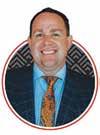


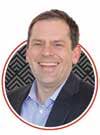


Forward-thinking business leaders are always looking for an edge. Well, what’s edgier than the teeth of a Shark?
Shark Tank is an immensely popular American business reality television series where small business leaders with creative solutions pitch some of the leading entrepreneurial minds (aka the Sharks) on their vision. Through those conversations, businesses are born, and trailblazing concepts launched into the marketplace.
With our current inflationary economic currents, clear thinking and decisive action are critical for today’s dental entrepreneurs. The DEO’s Shark Tank event in Chicago this fall provided attendees the opportunity to come to conclusions and make decisions using the realworld best practices and experiences of our industry’s leading “Sharks” in this space who aren’t just swimming, they’re at the top of their market’s food chain.
The “Sharks” of this event provided insight into the state of the market now and the coming recession, and gave practical, actionable advice DSO leaders can use to stay not just afloat, but ahead. Of everything I learned at this event, three insights stood out:
1. No margin, no mission
2. Processes are self-governing
3. Innovation is imperative
The eyes of a shark are perpetu ally open. As a DSO leader, yours should be too. Knowing your EBITDA number (Earnings Before Interest, Taxes, Depreciation, and Amorti zation) is critical to your success, and your company’s flexibility in financing will be severely hampered if your EBITDA margin is insufficient.
For a general dentistry DSO, you should have an absolute minimum EBITDA of 10%, and should really be

aiming for 20-26% at the practice level and 15-18% at the company level.
So what can you do if your EBITDA isn’t there?
There are ways to segment your company’s operations by stage of growth to improve reported EBITDA – these are called addbacks. For example, you could separate out de novos and create normalized earn ings for reporting to your bank, or separate out non-recurring or abnormal growth-related expen ditures, such as building out your management team. Sound accrual basis financials are a requirement when your senior bank, non-real estate lending exceeds $5 million.
Economic factors are at the forefront of our industry challenges. Wage inflation and the higher interest rates are beyond our con trol in an overall sense, but how we respond to these challenges is within our control.
Sharks are always on the move. One analogy shared at the event that really resonated with me related to this, that I think most people have experienced. Imagine you pull up to a Chick-fil-A® restau rant with an incredibly long line. At the same time, another car
pulls up to the Popeye’s across the street, where the line is short. Yet, the Chick-fil-A® line moves steadily and when you get your meal, you realize that the same car is still waiting across the street.
Simplifying your processes to improve the speed of service is key, and you can apply that knowledge to your own DSO to improve your EBITDA margin.
Fast service is process-driven, and you can implement simplicity and reduce handoffs in every aspect of your practice. Some examples include doctors explaining treatment plans to avoid any confusion, patients have the ability to check out in the
chair, and a call center with offshore staff handles the phone lines while your front office staff is free to work with in-clinic interactions.
Another way to create simplic ity and align your team is using the DEO’s own DEO MAP, which we got to see in action during a live imple mentation session at the event. But whatever the process you use, pro cesses are key to project manage ment, and a low-cost way to keep your business running smoothly.
There’s no other way to put it: inno vation is imperative. We heard so many stories of forward-thinking, creative ideas that are giving DSOs an edge among other marketplace

swimmers – here are just a few to get your fins wet.
One presenter had a simple model in some locations that com bines easy access hygiene with Ortho services. The branding is Beam ST Partners. They focus on patients in their twenties to early thirties, with appointments every 3 to 4 months, and have an extensive social media presence on TikTok and Instagram to market to reach those demographics.
Another presenter discussed their niche children’s practice, which combines same-day delivery of glasses with a dental visit. This model is quite additive to EBITDA with 50% margins. There is no mar keting expense, as the patient base of the practice refers the vision patients.
Yet another presenter is inno vating cart systems, which improve workflow and create a delivery system for supplies, making a cus tom cabinetry replacement, which is more efficient at less than 20% of cabinets.
And lastly, countless presenters discussed various creative ways they are using technology, and especially artificial intelligence. If you’re not thinking of how to incorporate tech and AI into your practice, you may be falling behind.
Margins, processes and innova tion. What ties all these together? Movement. These DSO “sharks” demonstrated that in these mar ket conditions especially, you can’t sit still.
Care Now, Pay Later SM Patient Financing.
With the cost of just about everything on the rise, consumers are stretching or saving their dollars. Healthcare is also getting more expensive, and patients are now responsible for out-of-pocket costs that were previously covered by insurance. Even greater numbers are lacking coverage altogether. Treatments that may have been ‘no brainers’ must be budgeted for, and many patients have to make tough decisions on what they can and can’t afford.
The result? A staggering num ber of U.S. adults report delaying or going without certain medical care during the past year due to cost. According to a recent survey, nearly 1 in 3 Americans haven’t been to the dentist since COVID-19.1 Among adults who reported an unmet den tal care need, 80% reported they could not afford the care.2
Most concerning is that the avoidance of care can ultimately lead to higher healthcare costs — people forego treating milder conditions that become more serious and ulti mately more costly to treat over time.

For healthcare providers, knowing a patient is choosing to forgo treatments due to cost can be troubling. Dental practitioners want their patients to be able to receive care – whether it’s a complex dental or endodontic procedure or an elective cosmetic treatment. To help increase patient access to care, Rectangle Health offers dental providers Care Now,
Pay LaterSM (CNPL) patient financing, and payment plans.
“Providing these options helps to ensure patients seek and follow through with the care they need. It helps providers keep their schedules full and ensures they will be paid for services rendered,” explains James Swan, Director of Enterprise Solutions at Rectangle Health. With Care Now, Pay Later patient financing, there’s a soft credit pull that does not impact a credit score, and nearly every applicant is approved. “Financial conversations become much easier at the practice, and a ‘We haven’t seen you in a while’ postcard announcing new payment options can go a long way in getting
patients back into the chair. For DSOs, this can mean hundreds or even thou sands of patients return to the office.”
From a process standpoint, CNPL applications are simple and provide patients with immediate, clear, and concise options for financing their care. Nonrecourse financing allows the den tal practice to have the satisfaction of beginning care with the patient while having the confidence of receiving payment without having to chase it.
With Care Now, Pay Later patient financing, providers are paid upfront, and patients can pay over the course of six months, up to 24 months, and in some cases, even longer. Swan continues, “Addressing the barrier to care results in a better patient expe rience, eases stressful financial con versations for staff, and improves the practice’s bottom line.”
Rectangle Health equips health care practices with the technol ogy and tools to attract and retain patients from registration to postcare billing. For more information and CNPL terms, visit: rectanglehealth.com/ solutions/care-now-pay-later.
1 www.byte.com/community/resources/article/reasons-people-skipthe-dentist/ 2 www.cdc.gov/oralhealth/publications/Unmet-oral-health-careneeds-of-adults-aged-20-64-years.pdf

Getting a more accurate depiction of your business’s financial position. BY PETE MERCER

Accrual accounting is an accounting method where revenue and expenses are recorded when a transaction occurs, as opposed to when the payment is made or received. This approach can provide a more accurate depiction of your business’ financial position, especially when compared to a cash-based approach.
DEO Magazine recently sat down with Hollie Williams, CFO at Rodeo Dental in Dallas-Forth Worth, Texas, and Mike Yates, CFO at Lumio Dental in Tulsa, Oklahoma, to discuss the value and challenges of accrual accounting for large group prac tices and DSOs. Both Williams and Yates recently led the change from cash-based business to accrual accounting in their organizations with great success.
DEO Magazine: Why is accrual accounting a better method for running a business?
Yates: I think we’ve all had that conversation or meeting where you talk about how much money is left in the bank. And depending on that number, it could have been a good month or it’s “we’re out of money in the bank, what happened?” I think we all look at accrual accounting as a way to make sure that the numbers are real. One area of focus for us over the last year is making the financials an operational document. They’re not a historical document, they’re an operational tool.
Williams: One of the basic things that happens when we go to school is we get taught about the matching
principle, where you match your revenues with your expenses. When you hear people talking about accrual accounting or GAAP financials, you’ll hear a lot about matching. For example, let’s say that you’re oper ating a dental clinic and your dentist is seeing patients that day. If you want to assume you’ve only operated
for one day – you open for one day and you close. When you do a cash basis financial statement for that day, there’s nothing that happened. Patients were served and you earned money, and employees worked and you owe them money, but nothing happened in your bank account that day. Your cash basis financial state ment would just be a big zero, and that’s not correct because you are owed money and you owe money. When you match it and you accrue for the revenue for that day, and you obligate yourself and accrue for the payroll, or you’re obligated to pay, then you can really see what happened.
These are the conversations I have to have with doctors for them to understand that activities hap pened, and you are obligated to pay your employees and your patients are obligated to pay you.
DEO Magazine: When should practices make the transition to accrual accounting?
Yates: My opinion is the sooner you can take that step, the better. It’s a lot of work to get from A to B and you don’t necessarily set a timeline of “OK, we want to be in the market in 90 days, let’s get an audit.” The quicker you can get this change made, the quicker you can start to roll it into your three- or five-year plan. You’ve got all the bugs worked out; you’ve got your systems gener ally in place. You’re going to be able to stand up to that audit per testing.
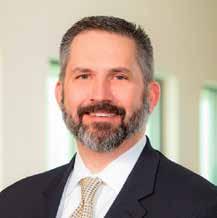
Williams: I would agree to the sooner, the better. Let’s say that you’ve got one dental practice and you’re planning on opening a second. And you know that in two to three years, you’re going to look for a larger financial partner. If you can get your financials organized while your data is still a little bit manage able, you can get your financials onto an accrual basis and then run on an accrual basis. Up until that point, you’re going to have history to be able to share with that future finan cial partner, because a lot of them are going to look at year over year perfor mance. And if you’re constantly having to say, “Well, this year is on an accrual basis, last year’s on cash basis. They’re not comparable.” It’s going to make your due diligence and the quality of earnings work a lot harder and a lot more painful.
DEO Magazine: How does accrual accounting impact the profit and loss statement?
Williams: The profit and loss state ment, your net revenue or the revenue you recognize, should be what you expect to collect for the services that you performed inside the month that you’re recording. We have fee schedules – some of our claims will have to go to Blue Cross, some go to Medicare or Medicaid, some for self-pay patients. If we bill $100 and we expect to collect $80, then we need to be recognizing on the income statement, revenue of $80. To under stand the reason for the difference, you must understand your contracts with your payers. You must under stand any discounts that you expect to give to your patients. And then you
also need to understand that some patients don’t pay the full balance of what they owe. And so that is the difference. You have your adjust ments, which would be your contract with your payer that says, “You may bill me $100, but I’m going to pay you 80.” And then your history will tell you what your patients typically pay you based on what you build in.
DEO Magazine: How did you have the conversation with your team about transferring to accrual accounting?
Yates: Doctors live and die by their production report and their collec tion report. We’ve made a big focus to also get them living by their profit and loss statement. Obviously, two different methods of accounting. What I’ve had to do is explain why the timing matters – how we can use today’s activity to project tomorrow’s collections? One of the things that I’ve recently started doing is actually walking them through a statement of cash flows. Because I know they’ll ask the question, “these are my collec tions, and my income statement’s not showing it.” So I will literally walk them through each component: “Inventory changed, that’s money sitting on your shelves. Work AR went way up. Yeah, you had all this production, but we haven’t been paid for it yet.”
It seems to really strike home. It’s a logical enough method for them that they can just say, “Oh, well, that kind of explains it.” It’s really been trial and error with each doctor to get them to understand the differences between the two and why a huge collection month doesn’t necessarily mean a huge net income.
DEO Magazine: How did your team feel about the change? Do they like the new method, or do they still wish they were cash based?
Williams: We don’t still wish we were cash basis. I will say that we’ve successfully made the transition. I had the most difficult conversations with the CEO at Rodeo Dental about the adjustment of gross production to net revenue in that collection rate and what’s sitting in that collec tion rate. I think everyone here is very pleased and very happy. It’s the forecasting part that has made life easier for all of us. It’s just to being able to truly have a forecast of what is coming. We have targets for what we expect weekly cash collections to look like. We still have reports on collections, and we can articulate what we expect to collect every week.
Yates: I think the executive team has really bought into it. We’ve got multiple MBAs on our execu tive team, so they understood the three statements, which helps if you trickle that down a little bit to the field. It’s funny, one of the things that’s really been difficult, which seems kind of straightforward is, inventory. Just even getting that concept down of why you want to count it, why it’s important and why your units are important. I agree with Holly that forecasting is key. We’re even looking at projec tions at an individual biller level now. The measured performance and compliance with those targets just give you a level of visibility and planning you don’t have managing off your bank statement.
How to spark your next big idea.
BY ED DALLWEIN, CPA, MBA, CHIEF FINANCIAL OFFICER, RICCOBENE ASSOCIATES FAMILY DENTISTRYhave us scheming about quotas. Those on the inside know the real message is to identify and inform the patient about everything that they need and let them decide what to have done. Few patients would rationally choose for their dental disease to go untreated. Providers who do not inform a patient about their dental disease are doing the patient a disservice. Best practice is for providers to identify industry benchmarks for disease rates and track their percentage of appoint ments where such diseases would be diagnosed.
We’ve all encountered a time when we have either tried or considered everything on our list of ideas to improve the financial performance of our dental organization, and we are at a loss about what to do next. This article proposes a few things to help spark your next big idea.
We sell chair time. We want to maxi mize chair utilization (butts in seats) and revenue per minute (collec tions). Turns matter. If a day is 8 hours long and appointments are 60 full minutes (including cleaning the room), a practice can only see
8 patients per chair per day. Reducing appointments to 50 minutes could increase that number to 9 and provide a 30-minute buffer for the day. Such a change could increase revenue for that chair by 12.5%.
DSOs often get a bad rap about pushing for production. Opponents
Studies show that patients often pass on treatment for financial rea sons. Offering financing options helps to remove that barrier. The best solutions take seconds for patients to apply and get approved after a soft credit check (no impact to their credit score). Some lenders even guarantee approvals for a siz able percentage of borrowers with poor credit.
People costs are by far the largest expense category for any dental group (compensation, taxes, benefits, perks, and outsourcing). A good exer cise is to create and measure ratios.
For example, how many dental assistants (DAs) or patient coordina tors (PCs) should an office have? Ask

a practice, and the answer is usually at least one more than they currently have. Instead, calculate and compare ratios. If you have multiple offices, compare lower performing offices with top performers. Consider talking with other providers in your area about their ratios. If your best office has 2 DAs per pro vider and your worst has 2.5, ask questions to understand why. If there is not a valid reason, consider reducing the ratio in the lower-per forming office. For PCs, the ratio may be a function of patient visits.
Hourly employees must legally be paid for all time worked, but reviewing payroll and time clock reports may show that they are getting paid more than their scheduled hours. A medium-sized DSO found that over 25% of its hourly employees routinely clocked in at least 15 minutes before their shift began. They reduced payroll costs by implementing (and enforcing) a policy that employees were to clock in and begin work ing at the start of their shift. (To remain compliant with employment laws, the policy also prohibited them from working before clocking in.)
An annual budget process is a great time to review all expenses, especially those that are repetitive in nature. While the output may be a budget for the following year, the true value of a comprehensive process lies in aligning the organization around common goals. It provides a forum for asking “do we really need that? How does it help us reach our goals?” When done well from the bottom up (justifying every dollar spent), companies can identify expenses that are no longer rel evant and should be eliminated. A common example is software licensing or support for products that no one uses.
Superior financial results come from holding people accountable for financial perfor mance. Every action in the business is

reflected in the financial statements, but it is often difficult for team members to under stand how they have an impact, especially since the various roles influence different elements. It helps to start with one metric that all office team members can easily understand and affect. Keeping the schedule full and percentage of actual production compared to goal are two examples. After the first metric takes on, it becomes easier to add more, eventually settling on three to five that work best for your culture.
Rewarding the team for achieving a metric aligns incentives and reenforces the desired behavior. The keys are to reward for outcomes, not effort, and make the reward meaningful. Incentives can range from bringing in lunch for every week above a target to extra money on pay day. The more impactful the achievement, the bigger the reward. Regardless of size, it helps to make the reward visible by broadcasting to the entire organization who hit goal and the type of reward (no need to publish an amount).
Any good financial advisor will say that the keys to long-term financial success are to begin early and to be consistent. Keeping an eye on your top line while managing expenses and enlisting your team to do the same help with that consistency. My hope is that one or more of the options presented here provided a spark to fuel your next big idea.
is
Officer of Riccobene Associ ates Family Dentistry (Cary, NC). He earned his MBA from Michigan State University and his BA from Walsh College. He has been in the healthcare industry for over 20 years in addition to a few others (soft ware, services, public accounting, banking, manufacturing, and retail). His varied background helps him see
from multiple perspectives and provide innovative solutions.
challenges
An annual budget process is a great time to review all expenses, especially those that are repetitive in nature.
While the output may be a budget for the following year, the true value of a comprehensive process lies in aligning the organization around common goals.

How labor management oversight leads to a healthier bottom line. BY CHRIS FOY,
CONTROLLER, DEOWhen running a business, whether it be a dental practice or a company in pretty much any other industry, our main goal is always to increase profit. On paper it’s a fairly simple equation – to improve your bottom line, you either need to increase your revenue, decrease your expenses or some combi nation of the two. Of these two paths to increased profitability, I always advise my clients to get a handle on their expenses first, as running a company that properly accounts for each dollar spent creates a foundation for your business that ensures as you scale you maximize your margins. And the most effective way to do that is with labor management.
Unfortunately, the labor market today is a tough one to navigate. Unem ployment is at all-time lows. The pandemic has changed the way employees think about work. Inflation has current and prospective team members wanting
higher compensation. And we are likely staring down a recession. That’s a lot to combat – the trick is not to overreact to these things, but to ensure your labor plan fits your practice. When you do that, you shield yourself from volatile forces in the labor market. For your labor plan, I recommend three areas of focus – 1) labor as a percent of over all expenses, 2) position pay bands, and 3) profit bonus.

An industry consultant pre pandemic may have advised that you keep your non doctor compensation around 25%. I think that’s a great benchmark, but I reject the notion that your practice must fall under rigid industry percentages. Rather, I think it’s far more beneficial that you look at all of your expenses and establish the model for your practice that suits you best. That’s not a recommenda tion to ignore industry standards – if you are significantly off, you should reflect on why you are so different than the dental space on the whole. But determine what that percent is for your business, and as you bring in more revenue and costs go up, make sure you add new labor costs you are maintaining in the same labor percent of overall expenses.
You love your employees – I get it. Your team members are the key to your success. But you have to draw lines in compensation so you are able to take emotion out of the equation when talking about increasing an employee’s compensation. Establishing pay bands (that are reviewed annually and inflation adjusted) ensures that you are maximizing your labor efficiency. Remember, you are paying for a job, not a specific person. Frequently prac tices find themselves with bloated payrolls that lead to hard decisions during tough economies. Remaining rigid in a pay band is ultimately a good thing for your employees, because you are ensuring that you are running your office in a way that maximizes their job security. I’ve seen too many cases of dentists that have to start letting go quality people because when revenues stalled out they had no choice but to look at their inflated labor costs. It’s important to remember staying firm on a pay band does not restrict your employee from having the opportunity to earn a really good compensation package. A
pay band should guarantee they are receiving a fair, market value base salary. But when your firm does well, they can share in the success with a profit bonus.
I firmly believe that any business that has employees should have some sort of bonus plan linked to company profit. When done right it addresses so many key parts of your busi ness – it rewards the people who contributed to the success of the practice and it doesn’t pull you into the trap many businesses fall into which is the expected bonus. When employees understand that their bonus is tied to company profit, they work better as a team to meet the shared goal. Further, they don’t get pulled into the unrealistic expectation that they will receive a bonus each year even if the practice is in no position to pay them.
Just remember, though, every dollar of profit should not be paid out in bonuses. You should identify a reasonable percent of that profit to be put into a pool and disbursed to your employees. Every profit dollar should have a place based on what you feel is appro priate for your office (owner disbursements, tax accounts, investments, capital improve ments, bonuses, etc.). It’s up to you to deter mine the best allocation of profit dollars, but making sure your employees are enjoying the success of your practice on some level is an investment you won’t regret.
Having a plan when it comes to compensa tion is critically important to your practice. It allows you to have comfortable control over your expenses in good times as well as bad. But the reality is, a plan is also a really good thing for your employees. It ensures that they are working for a practice that is shrewd in its business management and that prudency leads to job security while still offering great compensation paths.
Chris Foy is the Controller for the Dentist Entrepreneur Organization. He is also the owner of Dental Backoffice Solutions, a company dedicated to serving the accounting needs of dentists. He can be reached at chris@dentalback officesolutions.com


pulled from your data (e.g., provider days per location, patient visits or production per visit), you can choose which factor you’d like to grow.
Setting next year’s goals for your DSO can be daunting. Determining whether you need new team members to meet your production goals or how much you want to collect can make your head spin. You’re in luck – these three steps can help you set realistic goals for your DSO faster and more easily than you might expect.
The first step in easy goal setting is figuring out what each location’s calendar will look like next year and how many days they’ll be open. Mark the holidays, vacation time and any other days each location might not be open. Be sure to think of holi days or celebrations that only some of your locations might celebrate or take off, such as state holidays.
The next step in easy goal setting is analyzing the data from the past year. Once you have your baseline daily and monthly production for all your locations, you know what to expect from each location next year.
For example, start by evaluat ing each location’s calendar for next year. After evaluating their calendar for next year, look at last year – par ticularly the production per visit and how many visits they averaged per day. From there, they can predict their monthly average production per day. If that location averaged 10 visits per day last January at $450 per visit, they should plan for $4,500 a day for next January at their location.
Once you have evaluated your calendar and analyzed your data, you’re ready to set your goals. Start by determining how you want to grow your DSO’s production. Based on the factors you
If you want to increase the amount of production each location makes per visit, consider adding new high-value laser services or a small fee increase on common treatments. Since you’ve already evaluated your calendar and analyzed your data per location, you can easily plug in these small changes and see what a big dif ference they could make – and set your goals accordingly. You can even see if it would be more effective in one location versus another.
When evaluating your calendar, analyzing your data and trying to set goals, the wrong technology can slow your DSO down significantly. Jarvis Analytics works in the background all year to give your organization the data you need so you don’t have to enter data manually or spend time importing, exporting and organizing.
Jarvis can tell you how many days a month a doctor worked last year, how many patients a location saw in one day and even how many dollars they made per visit – all in seconds to make setting (and meeting) goals a breeze.
To learn more about how Jarvis Analytics can help your DSO reach your annual goals, visit our website, www.jarvisanalytics.com.





Finding the right CFO for your organization starts with understanding the skill sets and experience of prospective candidates.
 BY NICK KORHONEN, CFO, CORUS ORTHODONTISTS
BY NICK KORHONEN, CFO, CORUS ORTHODONTISTS
Ask 10 business leaders to describe the role of a CFO, and you’ll get 10 different answers. Herein lies the challenge for many entrepreneurs looking to build their executive team and set up their DSOs for success. The role of the CFO has evolved rapidly over recent years, with CFOs often wearing many dif ferent hats ranging from traditional financial reporting and analysis to strat egy development, M&A, change management, and much more.
Finding the right CFO for your organization starts with understand ing the skill sets and experience of prospective candidates. To help nav igate the complexities of the roles
that CFOs can play, we’ve identified four different profiles that can help you assess what kind of CFO you’re looking for and what role they can play in your growing DSO.
The Numbers Guru comes to mind for most people when they think of a CFO. This individual brings years of experience in traditional finance roles and is an expert with all things numbers. They know accounting standards like the back of their hands, are financial model ling wizards, and excel at taking numbers on a page, and turning them into a story understood across the organization.
The Numbers Guru has a nar rower focus than some other pro files, and they thrive when they can focus on what they do best. They are masters of optimization and leaders in continuous process improvement. The Numbers Guru adds significant value through detailed performance management, identifying opportu nities for efficiency through the sto ries their numbers tell.
The Strategist assumes a broader organizational role and partici pates in decision-making across all functions of the company. Together with the executive team, they identify where the company is headed and how best to get there. Internally, The Strategist has a deep understanding of all aspects of the business, extending beyond traditional finance, into Operations, HR, IT, and Gover nance. Externally, they have their finger on the pulse of the market. They have a deep understanding of macroeconomic trends and a talent for predicting industry trends and developments to proactively posi tion the company for success.
Instead of burying their heads in numbers, The Strategist under stands the bigger picture and moti vates teams towards a common goal. They require a strong core finance team to manage the dayto-day, so they can keep their eyes on the horizon and focused on the future of the organization.
The success of most DSOs is heavily reliant on two factors:
1. The successful execution of an M&A strategy
2. Securing financing to support growth ambitions
Enter The Rainmaker. This indi vidual excels in the art of negotia tion, understands capital markets and valuations, and can articulate the unique value proposition of your company to both potential vendors and financial partners. The Rain maker typically comes from a less traditional finance background, often investment banking, private equity, or M&A advisory.
The Rainmaker provides the most value in organizations with a heavy focus on inorganic growth. Their skill set is often not suited towards a focus on cost efficiency, or marginal process improvements, but on driving rapid expansion.
The Jack of All Trades has an unpar alleled ability to step into any of the CFO profiles as needed, and more. With the ability to simultaneously see the big picture and steer the orga nization towards a future state, they will also roll up their sleeves diving into the weeds to solve current prob lems. While they may not have the depth of expertise in specific areas, they don’t shy away from picking up new skills as they go to keep the orga nization moving forward.
The Jack of All Trades thrives in chaos and are well suited for ear ly-stage DSOs that are running with lean teams. They can provide the leadership team with the strength to drive your DSO forward so you can focus on building your team.
Knowing what profile is right for your DSO will require self-reflec tion to understand the current state of your organization. What skill sets does your team currently have, and where do you have gaps? Are your needs now the same as they will be in one or two years? It’s important to understand that the ideal CFO profile for your organization will change over time, as you mature and identify new needs. A young DSO may benefit from The Rainmaker to drive rapid growth, or the Jack of All Trades to put out all the fires. As the DSO matures, it will likely benefit more from the Numbers Guru, who can drive efficiency and process improvement, or the Strategist who can help bring the DSO to the next level.
Personally, I began as a selfprofessed Jack of All Trades, but later turned Strategist. Joining Corus Orthodontists, a doctorowned Orthodontic Support Organi zation, as its first CFO in 2019, my role has evolved as the organiza tion grew from no practices and a home office team of four people, to supporting 55 practices across North America with a thriving team with over 1,000 employees.
Every CFO will have a differ ent career journey with plenty of hills and valleys. It’s on the orga nizational leaders to find the right match for their company, and it’s up to CFOs to know where their skill sets lie, remaining open to evolving alongside their DSO as they reach new heights.
How DryShield provides a superior patient experience, allows dentists to work faster and increases the quality of care.
In today’s marketplace, comfort is paramount for any consumer-facing situation – especially in a dental office.
Yet traditional dentistry doesn’t typically get high marks for patient comfort. First, there are the four hands – two from the dentist, two from an assistant – to consider. Then the products – gauze sticking out of the mouth, cotton rolls stuffed in, a saliva ejector hanging off the side of the mouth, and bite blocks. It all adds up to a stuffy, time consuming, inefficient mess, one that consumers would rather avoid.
That’s why one pediatric dentist set out to create a positive experience for patients and improve procedural acceptance with the creation of DryShield, an autoclav able, all-in-one solution. With DryShield, there’s no need for cotton rolls, gauze, a rubber dam, or saliva ejector. It fits intra orally, is comfortable, and does several jobs at once. DryShield provides a comfortable experience, from the initial application of the product, throughout the pro cedure. And at the end, there’s no soreness or lasting feel ing of the product leaving a mark.
DryShield benefits dental group practices beyond just patient comfort: Boost productivity
By using DryShield, clinicians can greatly work with more autonomy and reduce chair time in the process. DryShield allows the clinician to do all the retraction, isolation, and suction, freeing up assistants for other tasks. Using DryShield, dentists report anywhere from 25% to 40% of reduced chair time on nearly every procedure. DryShield allows doctors, and by extension DSOs, to see more patients every day. There’s not a lot of products that will make you work faster and increase the quality of your result. DryShield is unique in that it will do both.
DryShield is the only isolation product on the market that has both autoclavable and single use mouthpiece options. It’s the most cost effective – and most durable – on the market. A dentist doesn’t want to have to spend $5,000 on an isolation
product and be on the hook for disposable mouthpieces that can cost upwards of $1,000 a month. DryShield would be an 80% reduction in costs if they’re utilizing the autoclavable.

Protect patients and staff
DryShield’s design prevents aspiration. It protects the throat and soft tissue, retracts the cheek, and by way of reducing chair time, makes appointments shorter, so that there’s less of an opportunity for anything negative to happen. In a survey of dentists, 87% noted that DryShield played an important role in helping manage aerosols, which is essential in reducing airborne pathogens.
Comfort, efficiency, cost savings, and safety – DryShield leads to higher quality dentistry in more ways than one. You can produce a more predictable result, and maximize production with less appointments to finish procedures. Now clinicians can focus on what they’re good at, and that’s restoring tooth functionality.
And as part of the Solmetex continuum of products, your facility’s water safety is covered from start to finish. The minute water comes into the office, until it goes out, Solmetex has the Sterisil, DryShield, and Solmetex brands to meet all a DSO’s waterline needs.



How one industry leader is on a mission to make dental finance topics more digestible.
Ken Kaufman knows the pressures other financial leaders in the dental space face. “We’re all trying to solve things that are hard to solve because dentistry is a con solidating industry,” said Kaufman, President & CFO of Nuvia Dental Implant Centers. “It’s consolidating, not consolidated. When it’s in consolidation mode, there’s not great off-the-shelf software to help solve and keep solved certain problems that finance leaders are trying to solve. There are a lot of challenges that take heavy think ing and a lot of work.”

Which gave him an idea. What if he could collaborate with other den tal finance leaders that are trying to solve the same problems? A couple of years ago, he made the idea real ity by creating the Dental Finance Forum. That first Dental Finance Forum meeting had six people. Today, the Forum has over 100 mem bers, with no signs of slowing down.
In a recent interview with DEO Magazine, Kaufman discussed some of the main topics covered in the Dental Finance Forum, best prac tices that have been created because of those conversations, and what’s on the horizon for Forum members.
The DEO: Tell us about the Dental Finance Forum. How did you get the idea and then when did it start?
Ken Kaufman: The thought process started a few years ago. Dental is such a great industry, and even if there is some competitiveness between different dental groups, there is always an over-arching willingness to help each other and collaborate when it makes sense to work together.
I was looking around and see ing that all these other great com panies have finance leaders. And we’re all trying to solve things that are hard to solve because dentistry is a consolidating industry. It’s not consolidated. When it’s in con solidation mode, there’s not great off-the-shelf software to solve and keep solved certain enterprise-level problems that finance leaders are trying to solve. There are a lot of challenges that take heavy thinking and a lot of work.
So I thought to myself, it’d be great if I could collaborate with other finance leaders that are try ing to solve the same problems that I’m trying to solve. As I started to think about it further, I realized a lot of people in finance aren’t great at networking and aren’t great at building up relationships and other resources around them. While CEOs are often great at networking within the dental industry, CFOs generally
other. If there were any follow-up or one-off conversations that needed to occur following the meeting, then they could happen. And dozens and dozens of those have occurred and great relationships have formed as a result. We have also connected as Dental Finance Forum members at various conferences, comman deering whatever meeting space we could find and having face-to-face conversations and masterminds.
aren’t. We tend to be heads-down, working on our internal business, often failing to build up a network of peers. I decided I wanted to break that mold, or that stereotype. And it turns out finance leaders love to network and help each other –essentially mastermind together.
A couple years ago I convinced myself there was a real need that no one was solving. So I decided to try to, in some small way, fill that need. I created a slide deck with a mantra and basic vision, and I approached a group of dental CFOs I was already connecting with on a monthly basis. They all loved the idea, so I decided to go for it, and the Dental Finance Forum was born.
The whole impetus behind it was to get finance leaders to hang out once a month and help each
Since our very first meeting, we’ve held monthly mastermind meetings. Consistency is key! And we’ve started to explore some other opportunities and ways that we can help each other.
The DEO: What are some of the common topics or challenges discussed?
Kaufman: Revenue cycle manage ment is one we talk about a lot; how to build the team, what technology and what software to use and imple ment, what outsource partners are available to help, etc. And honestly, it’s liquid gold, because everybody’s trying to figure this out. Patient financing is another common topic. We frequently compare notes on vendors, attorneys, and outsource partners of all types, sharing their
Without the Dental Finance Forum, finance leaders are left to fumble their way through things, learning from making some mistakes and iterating and pivoting through what can be a painful process.
strengths and weaknesses and helping each other make good deci sions in all of those areas, and more. We share software solutions we have successfully and not successfully implemented. We share best prac tices regarding associate compensa tion models, practice management software, equity models, lending solutions, and so much more. The world of dental finance is tremen dously complex, and dental finance leaders have a lot to accomplish and a lot of responsibility to help their organizations grow, mitigate risk, and serve all the stakeholders in
their organizations. It is a fun and exhilarating responsibility but can be overwhelming. Whatever short cuts we can help each other find brings tremendous value. Without the Dental Finance Forum, finance leaders are left to fumble their way through things, learning from making some mistakes and iterating and pivoting through what can be a painful process. My hope is that the members of the Dental Finance Forum shortcut, or even completely circumvent, as much of that as possible by their interactions with one another.
Another big topic is how to form and then implement the DSO struc ture and documents. This is com mon for those that want to grow up from just supporting a small group of dental practices to putting a more formal infrastructure in place that will allow nonclinical partners to be a part of the organization and possibly even invest. With this topic comes the best way to struc ture fees and create alignment with everyone in the company. The list of topics and discussion points goes on and on, but hopefully this gives the readers a basic sense of what we focus on.
DEO: Do you have an example of where a finance leader implemented a solution discussed during the Dental Finance Forum?
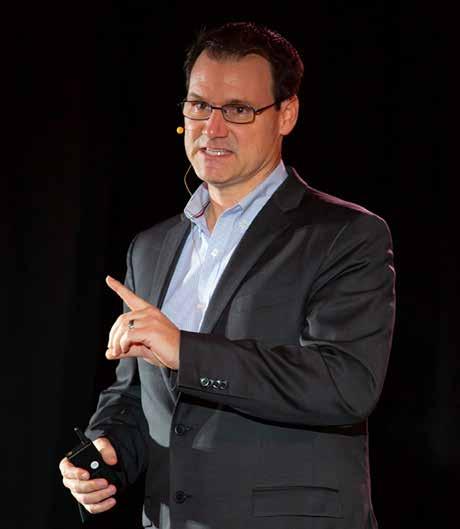
Kaufman: There are dozens. Many have been able to overcome years of frustration with implementing the DSO structure in just one meeting with the Dental Finance Forum.
In one example, a CFO was struggling with how to build-out a centralized revenue cycle manage ment team. This CFO was brilliant to ask the group for insights on this. With all the great minds on the call, this finance leader walked away with implementable processes and pro cedures that they could run with the next day, including how to build the team, how to set up the core accountabilities, and how to drive a very favorable outcome. I would guess we saved that CFO at least an entire year of piecing it together, and probably hundreds of thousands of dollars “learning” the best practices.


DEO: Do you have any long-term or short-term goals for the Dental Forum you can share?
Kaufman: In the short-term we are implementing a more in-depth and value-added Dental Finance Forum for members of the DEO.
For the larger groups in DEO with experienced finance leaders, we offer an exclusive monthly mastermind. This is a huge value for the dentist entrepreneurs who join the DEO – each of them get to send their finance leader to this monthly meeting and other opportunities to connect.
For the smaller groups with less seasoned finance leaders, we have a monthly coaching session where I work with them to address their questions and help them apply the basic dental finance concepts to help their groups profession alize the finance function to lay a foundation for growth. Again, this brings tremendous value to dentist entrepreneurs who don’t have the background or expe rience to train and coach their finance leaders. This is just one of the reasons why I recommend the DEO to so many dentists trying to build a group of practices.
Along with those DEO groups, we’ve implemented something similar at the ADSO, wherein Taylor Hawes, the CFO at Pacific Dental, and I run a study group that meets once every other month. Again, very much like the mastermind structure of the Dental Finance Forum, but exclu sively available for the finance lead ers of companies that are members of the ADSO.

Ken Kaufman earned a B.S. in business from Brigham Young University and an MBA in finance and entrepreneurship from the University of Georgia, where his peers selected him as the most outstanding student. Between his excellent academic record and his subsequent years of experience in executive roles for high-growth companies, Ken is a sought-after leader in all things dental finance.
Prior to Nuvia Dental Implant Centers, Ken was CFO of Community Dental Partners. He first joined CDP in 2016, at a time when the organiza tion needed to upgrade its financial leadership having expanded from 7 supported practices to 20. He was an integral part in helping the organiza tion grow to 80 locations.
Ken has received many accolades throughout his career, such as being awarded Utah Business Magazine’s CFO of the year and making their top 40 under 40. He will shortly be publishing a book on dental finance, and he regularly hosts podcasts on DSO Secrets. Despite his many achieve ments, he still gets an enormous kick out of his role in supporting clini cians as they build a new practice, welcome their first patients, and start making a real difference to their communities.
Ken has been happily married for almost 25 years and has 8 children. He loves spending time with family, serving in his church, and fitting in cycling, mountain biking, and an occasional triathlon to keep himself humble.






DEO: You’ve got a DSO finance book coming out in the end of November. Can you tell us a little bit about that?
Kaufman: Sure, this has been a great project I’ve been thinking about and working on for a while. I wanted to create something that would make dental finance concepts accessible to all, even to those who say they aren’t good at math or that claim to struggle with understanding numbers. To accomplish this, I asked

my daughter, who is majoring in English and Journalism in college, to help me write the book. We created a fictitious character named Julia, a budding dentist entrepreneur with five dental practices. The story follows Julia and her experiences as a dentist entrepreneur, including the roadblocks and problems that dentist entrepreneurs hit when they don’t have the finance part of their business where it needs to be. In the story, Julia reluctantly finds a

THE 9 REQUIRED CLARITY TOOLS
finance leader who helps her over come a myriad of problems by imple menting the 9 financial clarity tools outlined in the book. So my daughter created this character named Julia, and I supplied all the technical content on how to implement the clarity tools that Julia so desperately needs. My daughter, Ashley and I, sincerely hope this work will help as many dentist entrepreneurs and their finance leaders as possible. I’ve been a finance leader for almost 20 years, and in dental almost as long. I think this book will resonate with the target audience and provide digestible and actionable insights in a meaningful and impactful way.
Want to learn more, or sign up for the Dental Finance Forum?
Visit: www.dentalfinanceforum.com.


Choosing the right strategy for growing your dental group. BY PETE MERCER
Finding the right strategy to grow your dental group is quite likely a fruitless endeavor. In fact, there is no right way to grow a dental group. Each new location could require an entirely different approach from the one before. When it comes down to the argument over de novos or acquisitions, Dr. Maryam Beyramian of Westwind Integrated Health, Dr. Dwight Peccora of DDS Partners Management, and Philip Toh of The Smilist Management recently discussed the value of using different strategies to grow your dental group.
DEO Magazine: What made you choose your strategy for growth?

Dr. Beyramian: We’ve always been an acquisition model. From our first location back in 2008 until now, we’ve acquired our entire group through acquisitions. We target specific offices, usually very high flow offices. They have a healthy patient flow, but may not be well managed. So that works for us because we get to go in there and help them develop a culture, systems, processes and efficiencies. That’s what works for our group. We bring them onto our platform and our systems, we add our call center, and we add revenue cycle management. We distribute the work evenly among team members. And suddenly you see everybody shine and everybody become a better version of their position.
Toh: I wouldn’t say that we had the foresight to know one model was better than the other. Our first one was an acquisition, but we’ve also experimented with de novos. I think in the course of our life, we’ve done five de novos and 55 acquisitions. One of the things we did early on is buy underperforming practices, but it was a distraction to the organization. We were driven to grow very quickly. We really needed strong team players that fit in with our culture. When we’re pushing and finding all these different practices, the people are what is important. It’s easy to say on a piece of paper what a multiple should be and what the valuation should be. Ultimately, we find success in just identifying the right people, the right culture, and the right teams, so that we can continue to grow. We want to keep moving forward, not looking back.
Dr. Peccora: We started with acquisitions because we had to have some cash flow. We had to buy a business that
we knew we could make better. The main idea was that as we started to develop our model, we needed to identify where we can integrate and transition as best as possible. You get better at finding the right groups. Then, you get to the point where you build an integration team. I think that’s what has made the biggest difference is the culture integration team being able to go in and help that process happen so that the handoff was better. We started doing de novos only because it got easier. If you have a very solid integration team to make that happen, you can see profitability come a lot faster.
DEO Magazine: What KPIs determine whether you are going to buy a practice or not?



Dr. Beyramian: We classify our acquisitions into three groups: Class A, B, and C. Class A consists of practices that have well-functioning, high-producing teams. We can bring in some of our services that can enhance whatever baseline they have. We don’t do much in those practices.
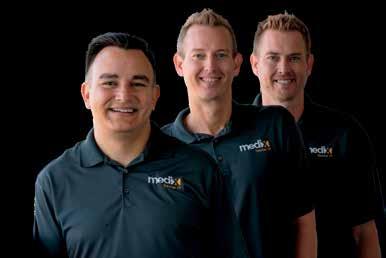
We look at new patient counts and hygiene counts, both of which are important KPIs for our group.
Depending on where those counts are, plus patient demographics and insurance, we classify practices as a B group or a C group. The B group does 300% and the C group takes about a year and a half to do that.
Toh: I would say early on, we were data nerds and wanted to collect every piece of information from the practice. But the reality is that if you know what the revenue or the top line of a practice is, we also want to know what the rent is and some of the compensation. Everything else is changeable, and it probably has changed and evolved even within the practice.
Dr. Peccora: A lot of KPIs are just getting a better under standing of the report card, whether it’s per patient visit or the health of the hygiene program. One of the KPIs we track is utilization rate and that’s usually where we
tend to find good acquisitions early on. The amount of hours per number of chairs, the amount of open hours and dollars being brought in at that time, the production. We use that utilization rate to get an understanding of how much we can optimize from a hub and spoke model, a typical healthcare model. Utilization rate is a huge part of how we triangulate ourselves.
DEO Magazine: How do you mitigate the culture change with an acquisition?
Dr. Beyramian: When we first acquire a practice, we spend a lot of time getting to know the people, talking to them and assessing their skills. I think the biggest tip is don’t dismiss the person that you’ve acquired because they don’t fit a model, box, or vision that you have. Give them time to warm up and get acclimated to the new company. Change is stressful, and change management is our job. The better
change manager you are, the more the team will follow you into the new vision you’re trying to create.
Toh: It’s super scary and anxiety filled. It doesn’t matter if it’s good change or bad change. They immediately go to the worst possible scenario. We want to be in touch and available. We station our integration team in the office, usually to cover simple things. What we’ve learned is people don’t necessarily have huge technical questions, they just like knowing they have support.
Dr. Peccora: Our integration team focuses on getting to know the clinical practices going on. Every single position swaps out with one of our main locations. So a doctor swaps in, gets to know the patients and gets to interact with the hygiene team. Same with the front desk. There’s a whole flow process to that. So, we see what’s happening daily.

Philip started his career in strategy consulting at PwC where he worked on engage ments for numerous Fortune 100 companies including The Walt Disney Company. He then joined as the 8th employee at HealthAllies, a venture-backed health tech company acquired by UnitedHealth Group, where he was the bridge between the business and engi neering teams in product management. After HealthAllies, he worked in venture capital sourcing and evaluating emerging technology startups.
After pursuing an MBA, he joined Henry Schein where he gained deep experience in multi-site dental and medical businesses. He’s proud to have helped grow a division over 500% and achieved budget for 36 consecutive quarters. After Henry Schein, he co-founded the Smilist, one of the leading dental support organizations in the New York metro area that has affiliated with over 55 practices.
Philip graduated with a Healthcare MBA from The Wharton School and a BS in Business Administration from the Haas School of Business at University of California, Berkeley. In his spare time, he enjoys running and has run four marathons including the Boston Marathon. When not running, you’ll find him on the tennis court with his friends and family.
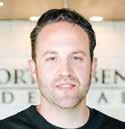
Dwight Peccora graduated from UTSchool of Dentistry in 2010 and partnered at the existing Fort Bend Dental in Missouri City, Texas (south west side of Houston, Texas). Dwight had a dream of developing a group practice that prioritized quality comprehensive care with all general and specialty care under one roof. Over the Last 6 years, Dwight has devel oped one mega practice in Missouri City of 10,000 square feet (which includes a CE facility), with three other locations throughout the Houston, Texas area to bring about access to this level of care for the Greater Houston area.
His greatest joy of practicing this way is the chance to collaborate among a team of doctors to find new and progressive ways to serve his patients.

He has taken the original Fort Bend Dental from $1.7 million to just surpassing $9 million among all locations as they onboard their 4th location this winter in the “hub and spoke model” of practices.
Dr. Beyramian graduated from the University of Michigan in 2001, and started Westwind Dental Group in 2002. In 2017 Primary Care Medicine was added to our service offerings and the group was rebranded to Westwind Integrated Health.
Today Westwind Integrated Health consists of 11 practices and over 20 doctors throughout the Phoenix metro area. “We recruit talented compas sionate doctors and mentor them in leadership skills, with the vision to develop providers who possess both strong clinical and communication skills.”
Westwind Integrated Health is a SERVICE oriented group created to provide comprehensive integrative oral and systemic care to patients of all ages. West wind promotes a collaborative environment where everyone from the multispecialty provider to the team members work hand in hand to ensure continuity of care between the patient›s oral and systemic disease. “We are all a team with one vision, to provide the best overall care for the patients who have entrusted us with all of their health care needs”.
Dr. Beyramian’s goal is to create medical and dental group that can provide integrative care for the Phoenix community. Her vision is to recruit and develop team members that value the corporate culture of collaboration and teamwork between multi-specialties to achieve optimal oral and systemic well-being.

Tips and tricks for DSOs looking to increase efficiency. BY NORMA ROMERO AND HUMBERTO ROMERO

Revenue cycle management is a relatively straightforward process that brings together the business and clinical sides of healthcare. It includes a range of tasks, including charge capture, claim submission, coding diagno ses and procedures, and collecting payments. However, the seemingly limit less number of variations available in the dental sector in terms of payers and processes means that revenue cycle management at many DSOs and dental practices is sub-optimal.
Revenue cycle management is an incredibly important pillar of your organization. When you build out your org chart, it should include everything at the practice level to do with entering the information into the EHR that is going to be part of or
included in the claims submissions. If you break it down, practice man agement or practice level employees are engaging revenue cycle manage ment activities every day, so you can centralize these processes all the way up.
It is really difficult to do every thing in revenue cycle management without assistance or doctor feed back or input. The whole process actually starts with the clinician’s notes about what the patient needs for treatment, and then it goes all the way through claims submissions.
Around 2012-2013, Community Dental Partners had eight locations. It was an exciting period for Commu nity Dental Partners – we had a vision
for growth, but not necessarily a direction for how to get there. Additionally, we weren’t sure whether the systems we had in place could withstand our vision for growth.
We were centralizing everything, and we started creating reports so that we could begin to utilize data that we weren’t getting from Dentrix. Until then, everything had been measured by feelings and assumptions, which obviously doesn’t generate the infor mation that you need to develop an effec tive system. We changed our systems from Dentrix to Open Dental and began to create a collections report that we still use today.
The collections report was developed because we needed a way to track KPIs while we were still growing from eight loca tions. With so many different performance indicators to keep track of, like collections, appeals, and claims, the collections report is an invaluable tool that gives us better insight into how our revenue cycle management processes work for our organization.
Not only did this report give us better data on the financial comings and goings of our practices, it also gave us the data on the peo ple working at Community Dental Partners. One of the things we noticed was that some of our “amazing” employees were not actually that amazing. It turns out that they were not being as efficient as we thought and were just sending claims without auditing them first.
We use Open Dental to assign tasks to each dental practice and to follow up on any thing that they need, whether it’s a doctor or an assistant. We make sure they get it right with a quality assurance team. If everything is good and clean, we can hit submit all day. But if there are any issues, this team pushes tasks back to the practices to fix them.
Once we started to develop better systems for our revenue cycle management processes, we began to establish better teams to oversee

each step of the process. This was partially out of necessity, as we realized every month that we were adding a few more practices to the organization, and we knew that the system would not have been able to support that kind of scale.
We started with a full-time, in-house bill ing trainer to train the front desk staff, new practice managers and billing employees on our system. With as big as we were getting, we realized that one trainer for 70 locations (and we’re still growing), would not work either. Now, we have another training department that we outsourced to the Philippines that works with all of our new billing employees, while the Community Dental Partners trainer will train practice managers and front desk staff.
Part of the challenge in running such a large DSO is finding ways to increase effi ciency throughout the organization. One of our key findings was that our teams need to be siloed off – while working with each other is still a necessity, it’s important that each department was only working with their spe cific responsibilities. When an employee is constantly switching tasks between auditing claims, appeals, and posting payments in the system, it’s really hard to maintain efficiency with that kind of workflow. If our employees are on the claims audit team, that’s what they do all day long.
Because Community Dental Partners is responsible for so many practices, we have a huge team that works with revenue cycle man agement. We run about one and half employ ees for each location, ensuring that each of our dental partners has the support and attention they need for their revenue cycle management.
Our team is constantly growing, which is always exciting and challenging! While we are always looking for ways to increase efficiencies for our dental partners and trying to improve our processes along the way, we have built a revenue cycle management team that we are very proud of.
Norma Romero started at CDP as a financial assistant in 2010 and held several other positions before becoming Chief Compliance Officer in 2015.

The keys to optimizing revenue cycle management for your dental group.
 BY DR. TAREK ALY, BDS, MBA – CO-FOUNDER, CHIEF OPERATING OFFICER, ORTHODENT
BY DR. TAREK ALY, BDS, MBA – CO-FOUNDER, CHIEF OPERATING OFFICER, ORTHODENT
Refining and tweaking processes is an endless journey for entrepre neurs and business owners. While we are trying to stimulate growth in our organizations, it’s going to take some digging and adjusting on the part of the business leader to get to the heart of the issue. This is especially true for anything related to finances, which is why dental practices should be establishing a revenue cycle management process within their systems.
What is revenue cycle manage ment? It’s the process where you are converting every single dol lar that walks through your door into real cash that can go into your bank account. I like to think of the money that comes through the front doors of your practice as “Monopoly money” – it isn’t real until it actually hits the bank. Revenue cycle man agement is the process that takes the money you are bringing in and puts it in your bank.




My good friend Emmet Scott has a saying that I love – “We’re not really doing billing, we’re not really doing revenue cycle management. What we’re doing is preventing fraud, waste and abuse.” Revenue cycle management can’t be patched haphazardly; this is a critical pillar of your organization that must be done right to be successful.
Measuring appropriate key perfor mance indicators is essential to the success of any revenue cycle management program. Whatever needs to be changed first has to be measured with scientific data about your practice.
There will be some variations based on where you are, so don’t forget to take geographical factors into account. Your payer mix will make a difference as well: practices high in Medicaid patients will have different results than those who have a high number of PPO patients.
To truly get your organization started on the right foot, whether you are implementing revenue cycle manage ment or not, you need to establish standard operating procedures for your entire team. While it might look different person-to-person and roleto-role, everyone on your team needs
but it will also ensure that any new team members coming in will know the expectations and processes required to work with your organi zation. Speaking from experience, once we standardized how things were done, errors went down signifi cantly. Without the proper protocols in place, it’s very possible that your hard-earned money is going straight out the door.
There are 5 main phases of Revenue Cycle Management:
1 Eligibility Verification. Data gathered from a standardized form called “incoming patient informa tion sheet” is used to start the veri fication process, usually a couple of days prior to the patient coming in.
Key performance indicators show us that what we’re seeing is not perception, but reality. You could claim to have the best billing department in the whole world, but the data could tell a different story. Likewise, you could claim that you have the worst billing department in the whole world, and the data could tell you the opposite. The only real and accurate judgement of quality is with numbers.
Track KPIs like collection to pro ductions ratio, adjustments to pro duction ratio, days of sales outstand ing, aging to production ratio, etc.
a set of standard operating proce dures to understand the parameters they should operate in.
Establishing standard operating procedures will unify the efforts of your entire team, aligning their work towards a common goal: operational success. The revenue cycle man agement process needs standard operating procedures to ensure that all your finances – incoming and outgoing – are being documented promptly and accurately.
Not only will standard operating procedures align the work of your team to the goals of your company,
2 Claims Submission. When the patient comes to the practice, we will take care of the procedure, whether it’s hygiene or a treatment, and we must make sure that whatever done clinically is correctly documented in the chart and in the ledger. Then the claims are batched and sent to the clearing houses.
These charts and ledgers must be accurate and up to date to make sure that your doctors and your organization is in compliance. A huge part of that is making sure that the doctors are making accurate and clear notes to properly document every step. Without that documen tation, you risk not meeting the standards of the industry. Non-com pliance is a huge risk to your organi zation and your entire team, so it’s critical that all of this information is accurate and up to date.
It is advised to opt in to an Electronic Funds Transfer (EFT) option to receive your money quicker electronically and to have a documentation of the EOB that lives on the cloud forever.
3 Explanation of Benefits (EOBs) processing. Once the insurance company verifies your claim, they issue a check attached to an explana tion of benefits sheet. At this phase, your team logs the payments made to reconcile with the patients’ accounts and handles denied claims with the insurance companies.
It is advised to opt in to an Elec tronic Funds Transfer (EFT) option to receive your money quicker electron ically and to have a documentation of the EOB that lives on the cloud forever.

4 Aging Analysis & Rectifying. This is the crucial stage where we analyze the reasons the patient accounts have aged. This data is used
to create a preventative process to avoid the issues from happening in the first place. An aging analysis report is advis able to make this data consumable.

5 Auditing. A system without an audit is like a speed sign without enforcement by the traffic police. Your system will have little value without the proper audits and follow up.
Remember that you cannot improve what you cannot measure, and you cannot measure what you cannot define. Work on your KPIs, systems, and processes, and don’t forget to audit them. You don’t have to be great to start, but you have to start to be great.
Tarek Aly practiced Dentistry and Peri odontal surgery for years while simulta neously working in Management and Marketing. His expertise includes M&As, Business Valuation, Human Resource Management, Business Operations, Dental Organizations Management, and Dental Support Organizations platform develop ment and management. He is currently the Chief Operations Officer/Co-founder of OrthoDent Management LLC.
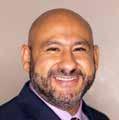
Choosing a growth strategy isn’t always as big of a challenge as we make it. Sure, it’s important to find a strategy that fits your vision, mission, and goals, but there isn’t a right or wrong answer. Perhaps even more importantly, what you do for one part of your growth journey could be entirely different from what you do for another part of your growth journey. Just because you start out with acquisitions doesn’t mean that you must keep doing acquisitions for the rest of your career.
At Community Dental Part ners, we have run the gamut of ways to expand our organization. We have used a combination of acquisitions, de novos, and even partnerships to get where we are at today. We have some incredible things ahead of us, but it’s taken an enormous amount of work, and
several different strategies, to get here. As our CEO Emmet Scott says, “We are a 13-year, overnight success.”
Before you can make an informed decision about which path you want to take on your growth journey, it’s important to understand the value in each approach: de novos, acquisi tions, and partnerships.

People often ask me questions like, “Why do you do de novos? Why do you do acquisitions? What’s your strategy?” When I consider what building a de novo actually means, I remember that it’s where we started. Our first 10 practices were de novos, and most of the facilities we built were huge –incredible facilities that were anywhere from 5,000 to 7,000 square feet, with play gyms and movies to make the patient experience (especially for kids) better.
We really wanted to take on the psychology of dentistry, removing any barriers that would keep people from getting excited about walking in the front door. Because we had a lot
Want to seamlessly integrate clear aligners into any practice?
Meet CandidPro: an orthodontic system exclusively for dental practitioners.

Get started at candidpro.com

Standardize treatment protocols across all locations to drive consistent outcomes.
Deliver top-tier treatment plans using any intraoral scanner.
Offload non-clinical support to our Care Team via CandidApp™, the #1-rated app in clear aligners.
Get treatment planning support for every case from our USlicensed orthodontists.
CandidPro gives DSOs centralized treatment planning through user-friendly technology. The results are consistent, so there’s no miscommunication between doctors.
Dr. Roshan Parikh, CEO, dntl bar

>
Growth of pediatric patients, our main goal was that kids would be crying because they had to leave –not because they were showing up. De novos were a no-brainer for us because we wanted to be able to build something that falls into a clinical alignment with what the clinicians wanted to do.
De novos are an important competitive advantage, and one of the best returns on your money that you are going to get. One of the downsides of de novos is that it can be difficult to get funding, especially once you get to a certain size. After you grow to a cer tain size, banks will start to get nervous and could start to turn you down.
With acquisitions, the growing pains of getting new financing, constructing facilities and getting patients aren’t nearly as difficult. By acquiring the existing patient base, which means that you are also acquiring an existing flow of cash, the banks have an easier time working with you in these scenarios.
Some of Community Dental Partners’ first acquisitions were 11 practices in Texas. Our team was very confident that what we were bringing to these practices was amazing. An amazing culture, incredible benefits, and a solid organizational structure. When you looked at everything on paper, it seemed destined to work. We had about 50% turnover in those practices, including a bunch of the managers.
We go into every acquisition with the goal of retaining everyone. It doesn’t always work out that way, but it’s always the goal. The real ity is that turnover is likely going to happen with an acquisition, no matter what. Despite the fact that you could be creating a better work environment, it’s coupled with a different set of standards and expectations that some people are going to have a hard time adjusting to.
It’s that change in processes, manage ment, and culture that can leave people shell shocked and create the most friction in these scenarios.
Most of the “acquisitions” we do at Commu nity Dental Partners are the partnership route, but there is an important distinction between acquisitions and partnerships. Partnerships are the most challenging growth strategy because they’re practically marriages. It’s the act of “sticking around,” in a business sense.
You will be leading with and working with this person, making difficult business decisions together because, as a partner, they are a huge part of that process. Through our partnership program, we have the oppor tunity to train young associates with what is essentially an MBA program. We usually start at the recruiting stage, gauging interest on any potential partnership candidates. But we don’t make any of those decisions lightly because a partnership relationship is so sig nificant to the success of the business.
We are very careful about this process, because we hired a “false positive” through our early partnership process. He understood the business and had a vision for what he was going for, but he was ill-equipped to handle the roller coaster ride of partnering on a busi ness venture. Partnerships can be an incred ible opportunity, but it requires both sides to literally step up to the plate and deliver what’s required to keep the business running.
At the end of the day, there’s no right or wrong growth strategy for your business. As long as your organization is growing at a healthy pace, your associates and their teams are happy, and you are making a profit, making the choices that make the most sense for you.
As one of CDP’s co-founders, JD Stacey drew on his many years of experience as a counselor to help create an organiza tional company culture in which employees and patients could thrive. He is currently the company’s Chief Growth Officer.

Through our partnership program, we have the opportunity to train young associates with what is essentially an MBA program. We usually start at the recruiting stage, gauging interest on any potential partnership candidates.





Why finding the right banking partner is critical to securing the kind of debt financing that your practice needs to grow. BY PETE MERCER

funds where they are purely placing debt and not taking an equity stake in the DSO. This approach has pros and cons to it. One of the pros is that since they are not a commercial bank subject to all the regulation that banks are, they allow higher leverage. They also understand risk on a more granular basis than banks, which can help you to get higher facility amounts.
Securing financing for a business venture is always a complex process that requires due diligence on both sides of the equation. This is especially true of healthcare and dentistry, because of the extra compliance regulations that other industries might not have.
Even though the dental industry has proven in the last 12 to 15 months that it’s bounced back from the pandemic, bank appetites don’t bounce back as quickly. Most banks
won’t have the appetite to lend in that kind of environment where there’s a lot of uncertainty in the financial markets.
One approach DSOs can use is private equity debt funds, which dif fers from private equity investment
The downside is that it’s a higher risk and more expensive. Pri vate equity investment funds have much tighter and more comprehen sive reporting requirements as well. With debt funds, they want monthly financials and monthly certifica tions, requiring a different data set than most banks. Not only the bal ance sheet and income statements, but they want a statement of cash flows. Your organization may need financial reporting expertise to pro vide that information. Additionally, where a commercial bank might have about five questions for you with each reporting package, you should expect to get 10 to 20 ques tions each month that will require granular explanations.
The most important attribute to have is a proven track record, which is tougher for emerging practices. Some groups might be running up to five practices really well, but once you get up to 10 or 15 practices, it’s
a completely different animal. The traditional bank debt route is going to be more restrictive on the amount of capital that they will give you. They have a much lower risk toler ance, so it will be a much slower process to get things moving.
These institutions will also be looking to see if your DSO is com pliant on a regular basis, regarding things like legal structure, manage ment agreements, and operating agreements. That gets even more complex because regulatory require ments vary by state – so if you’re operating in multiple states, they will be checking differing qualifica tions for compliance.
Finally, the bank will want to ensure that there are no cash leakage points within the structure of your organiza tion. If there are leakage points, that cash will still need to go back to the DSO to pay that credit facility back.
There aren’t many DSO specific lenders out there, especially when you consider that healthcare is a specialty lending industry. Dentistry is a niche within healthcare, which makes DSOs a niche within a niche. For banks to execute on DSO lend ing, you need to find DSO specific healthcare experience lenders to be able to run that group for you.
There have been plenty of sto ries of banks that have gotten into
the DSO world, but they try to use regular GNI lenders – general ists that are being pushed to work within the highly specific healthcare lending space. The next thing you know, those banks have a portfolio of healthcare deals that are either poorly thought out or poorly struc tured. This leads to losses, and these banks are out of healthcare in a mat ter of years.
Finding the right banking part ner is critical to securing the kind of debt financing that your practice can leverage into a growth opportunity. Doing your due diligence and having patience for the process is all a part of the journey.

Three trends to watch, and how revenue growth is a team goal. BY MARGARET MCGUCKIN, CO-FOUNDER & PRINCIPAL, I3 IGNITE
There is no issue more important to your dental group than increasing top-line revenue. Top-line revenue is the most important thing for you to focus on because it creates value for your business – the kind of value you need for your organization, which is consistent and accelerated growth in revenue.
I am the co-founder and prin cipal of a consulting firm called i3 Ignite, where my business partner Kathy Lynn-Cullotta and I advise businesses that are in growth and scaling mode in a variety of indus tries. We work with companies who provide services like dentistry and suppliers who are trying to build customers and revenue.
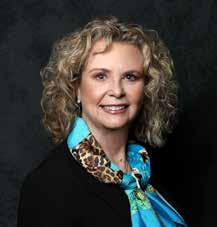
What I’m hoping to accomplish here is to get you to think differently about your business, and more specif ically to think about what you could do differently in your organization to impact revenue growth. I want you to walk into your office and have a better understanding of how you can generate and leverage top-line reve nue growth that will yield the results you need for your organization.
I believe there are three trends that are impacting the future of revenue growth. For group practices and DSOs, those trends are consum erism, competition and technology. When I was at ClearChoice Dental Implant Centers seven years ago, we
were pioneers in direct consumer dentistry. Consumerism was this tiny trickle that we were trying to tap into, but now consumerism is practically a tsunami. It’s here, in a huge way.
Even specialty practices are not immune to consumerism. There are specialty practices who have tradi tionally relied on referrals for their revenue growth, that are finding that their revenue growth dollars year over year are coming from their direct consumer efforts.
Five years ago, were there nearly as many strong DSOs and large group practices as there are now?
The competition was very different from what it is today. There are very strong brands out there today that are all actively competing against each other, and the competition is growing every day. I guarantee you that there is more in the wings, ready to join the fray. We are not done with new start-up DSOs.
Technology is a tremendous gift for modern DSOs and large group practices. The right technology can increase the quality of care that you provide, while decreasing your overhead costs. Additionally, it can continue to raise the engagement you have with both consumers who are not yet your patients and your current patients. Technology acts as a sort of silent business part ner – the best pieces of technology aren’t attention grabbing, but they do incredible things to move your business forward.
The revenue equation is some thing that most of us are probably familiar with. You need to interest people in your practice, get them to contact you, convert them to be your patient, and retain them over time. This creates revenue for your practice. While this might have been easy at one point, those three trends are making it more difficult every day to operationalize increases in revenue. It’s only going to get more difficult as we move into the future.

Another strategy to generate and leverage top-line revenue growth is to think through your higher value procedures strategy. Here are three easy steps:
No. 1: Categorize what a high value procedure is in the practice. Develop the criteria for what a high value procedure is. Over $1,000? Over $5,000? Over $20,000?
No. 2: Using data, identify where the strengths and weaknesses are today. What percent of procedures fall into the
high value category? If you’re a referrals-based practice, who are your best sources of high value cases? If direct to consumer, what sources/leads are most qualified? What’s the conversion rate on these cases vs. all other cases? Who’s the best at converting high value cases? Exactly what are they saying and doing? What can others in the practice learn from them?
No. 3: Create your Opportunity Statement. An example of an Opportunity Statement: “How can we increase our high value procedures by X% in the next Y months?” Develop the Opportunity Statement as a team. Then, create a very simple action plan: who’s going to do what, by when, etc. And, hold each other accountable.
Part of the challenge that business leaders have in generating revenue for their organizations is not understanding your market. Who is your target audience and how can you better serve their needs? This is especially important for dental practices, because your target demographic can change from practice to practice based on where you are located and what specific services you provide.
When you have a really sharp focus on who you are targeting, you’ll have a better chance of reach ing them through all the noise of the competition. You need to know
what your target market is looking for, and you should have an intimate understanding of what makes your practice unique.
Another thing that emerging practices really need is to focus on keeping the virtuous cycle going. The virtuous cycle starts with a sin gle occurrence, like a happy patient. That occurrence causes something else, and each positive occurrence will start an upward spiral, continu ously improving your business.
One of the most important things for emerging practices and DSOs to understand is that sales is not a dirty word. It doesn’t mean that you are presenting treatment plans that are either unnecessary
or not right for that patient or con dition. What I’m referring to is the consultive selling approach that uses the patient’s needs to really drive the conversation.
It’s everyone’s job to provide revenue for the practice: the front desk, the doctors, dental assistants, treatment coordinator, and patient education consultants. When every one works together towards a com mon goal (i.e. generating revenue), everyone is responsible for the success of your practice. If your team isn’t using daily huddles to brief one another about sales and revenue opportunities for the day, then you are not using your huddle time effectively.
Margaret McGuckin is an expert in growth – whether it’s turning around a situation to get back on the growth track or scaling quickly. Her passion is getting results in a way that’s sustainable, which she’s done successfully as a C-level exec in both Fortune 100 companies and startups.
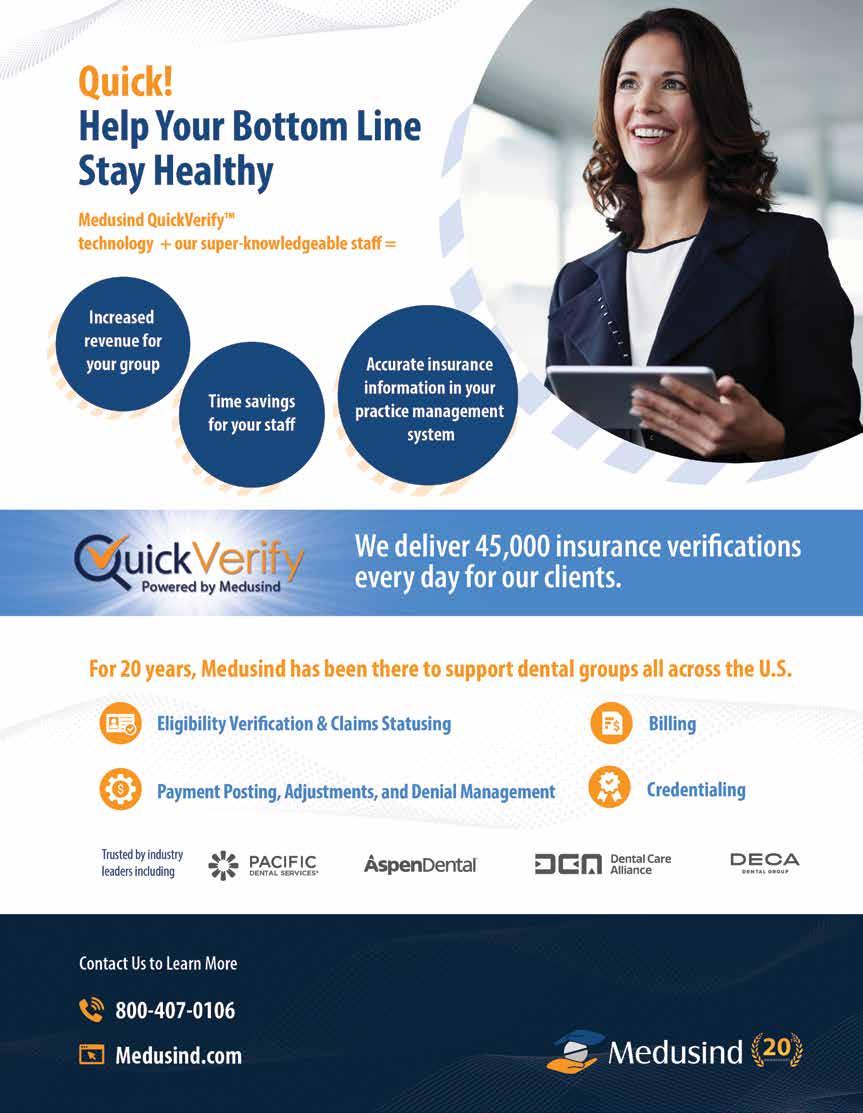
Banks should be a partner to dental groups as they grow. BY DANIEL BEAIRD
a bank at some point, you need to have that discussion so that pre payment penalties do not hamper growth when it is time to refinance should that bank not be able to scale with you. You don’t want to be stuck with that one lender and they tell you at close they can’t lend to you anymore, and you have a three-year prepayment penalty on that loan.”
Montgomery said interview your banker and several more. Find out what’s the best for you. It might be personality. It might be how far they’re willing to grow with you.
A relationship with a bank shouldn’t be transactional. A bank should understand a dental practice and business, be a partner to it, and know how it wants to grow. Live Oak Bank, headquartered in Wilmington, N.C., serves small business owners in all 50 states and has worked with emerging DSOs in raising debt financing to help dental groups grow and scale.
“If your relationship with your bank feels transactional and you have to provide the same informa tion every time that you’re doing an acquisition and it takes three months to close, that’s probably not going to be a relationship you want to stay in as you scale,” said Mike Montgomery, Senior Vice President of healthcare and middle market lending for Live Oak Bank.
A dental group should always have a conversation with a bank about their goals. What’s the plan? What’s the vision? What’s the time frame? Dental group owners should have a list of financing questions ready for banks to answer.
“As a dental group begins to scale, prepays can become a pretty big issue for them,” Montgomery added. “If you’re going to outgrow
“So just as if you were inter viewing someone to hire into your practice, you need to do the same with your banking relationship,” he said. “We often talk to folks three to four times before we even start look ing at financials, and often we meet them in person. So, it’s important to the bank too.”
Montgomery said a lot of dental groups come to Live Oak Bank not expecting any personal guarantees. They want to have a loan without recourse, and he said, “we can maybe get to that level, but if you’re at $2 million in EBITDA, we’re going to still need to grow because you have a lot to still do with building out the infrastructure and continuing to


grow those practices. To us, it’s typi cally $5 million in EBITDA when we can possibly do a burn off.”
That means there’s a personal guarantee and once the next thresh old is hit in corporate EBITDA, there are quarterly compliance covenants. “Maybe we have a set-in-stone that once you get through six or seven cov enant periods which you’re in compli ance, plus we can reduce or completely remove that personal guarantee,” Montgomery said. “We’re going to work with you as you grow and scale, and covenants are going to start becom ing more important. For us, it’s always been about cash flow and leverage.
Montgomery said typically banks aren’t willing to go over about three and a half times on senior leverage. “It’s not a black and white credit box but it depends on a number of things regarding your enterprise,” he said. “What is the current infrastructure, what’s your EBITDA, what are your margins and what’s your organic growth? Typically, you’re going to see a senior leverage that’s a debtto-EBITDA ratio around three and a total that could be four, even five times. That gives you a little flexi bility as you’re trying to grow and scale your practices.”
He said there are two lever age points Live Oak Bank looks at: senior leverage and a total leverage covenant. “Senior debt to EBITDA ratio, meaning first lien debt with your primary lender, the bank will often require this first position on the management company and those operating companies,” he said. “Then
there’s a total leverage covenant –including both senior debt plus any additional subordinate debt related to the business – maybe there are some seller notes or equipment financing through a Patterson, Benco or Henry Schein (commercial real estate debt is excluded from this calculation).

With banks’ individual lending thresholds in play, some banks have partnered together on opportunities where dental groups are growing. “They may exceed the legal lending limit of one bank as they scale. However, this does not necessarily prevent the bank from continuing the relationship. As the agent bank, we bring in other lenders to share in the credit, often called a syndication or participation where one bank is the lead for servicing and the others
come in behind as silent partners and provide additional debt. So, there’s a way to scale without going to private equity before they are ready.”
“But we’re also working with a lot of private equity groups,” Montgomery continued. “We like what they have to offer. A lot of groups pre fer using private equity at an earlier stage if their growth plan is faster than most banks can keep up with, with debt alone. We’re seeing once you get into $20 million in EBITDA, it’s 12 to 16 times multiples and that can hap pen in a three – to five-year span.”
Montgomery said it’s important to network because no one has gone through this by themselves. “There are many people in the DSO indus try that have done this before and they are willing to share that secret sauce,” he said. “Interview different people. You’ll get some best prac tices and it’s going to help you.”
Mike is SVP – Healthcare Sponsor Finance for Live Oak Bank. He works in Live Oak’s Specialty Finance division, providing solutions to middle market clients and sponsor finance. Mike’s back ground is in healthcare mergers and acquisitions with a concentration in the Dental Service Orga nization sector. Currently he works with groups ranging in $2 million to $20 million in EBITDA. Previously, he worked with Live Oak’s healthcare team as a senior loan officer, where he developed business strategies in lending to the industry and structured loans to doctors and dentists for expansion, construction, commercial real estate and various other business purposes. Mike joined the Live Oak team in early 2013 after seven years with SunTrust Bank. Mike has a business degree in finance from the University of North Carolina Wilmington.

Evolving the strategy and messaging are key to building strong core values through growth. BY
As an emerging DSO grows its business, its strategy and messaging must evolve. Patrick Nelson, Chief Financial Officer of Salt Lake City-based Platinum Dental Services, knows that firsthand. Platinum Dental Services was founded in 2012 and he joined in 2015.

“In the early days, our training focused on metrics and pre-appointment hygiene rates as well as new patients, retention and average daily production,” Nelson said. “All of those metrics are very important, and they help drive suc cess if you get them right. But if the focus is solely on metrics, it isn’t very inspiring to other people. So, last year, we got really serious about defining our core values.”
DANIEL BEAIRDPlatinum Dental Services started documenting its core values around service, teamwork, humility, educa tion, family and relationships.
“We gathered a lot of feedback from our partners,” Nelson said. “And we went on a tour across all our locations.” That’s 23 locations in total with 17 in Utah and three in Colorado.
Platinum Dental Services drives better performance working toward a common goal. “For example, if we want to talk about patient retention and case acceptance, let’s not talk about the metrics. Let’s talk about what impacts the metrics and that’s patient experience. Let’s treat the patient great and make sure they feel comfortable,” he said.
A lot of metrics fall into place when core values like these are focused on. Nelson found that they get more emotional buy-in from their team members and doc tors these days, and that creates a unifying voice.
“People knew what we stood for and that built up our goodwill,” he said. “We should have focused on our core values sooner than we did, but I think that’s a com mon mistake among many DSOs. Our core values have aligned our shared vision and goals, resulting in changed team behavior.”
Nelson said you must believe your core values, and you have to talk about them, otherwise they can become just another poster on the wall. “We had team members, at times, call us out about that,” he said. That’s a good thing, according to Nelson. He added it shows that Platinum Dental Services’ core val ues resonate with its team members. “It requires effort and time, and you have to talk about your core values to make sure you remind yourself and your team members what we believe,” he said.
One of the biggest mistakes emerging DSOs make is failing to set the right expectations for its team from the beginning. “In the early days for us, for example, our expectations, agree ments and contracts with some of our doctor partners were pretty loose,” Nelson said. “They weren’t very explicit as to who does what and how the economics were split and how we made decisions about investing in new equipment and new software. In most cases, we’ve resolved that. In other cases, it’s ended poorly. But as the business evolved, our strategy and partnerships evolved.”
Nelson said setting the right expectations goes beyond the dayto-day business of the practices and into hiring the right people. “When hiring, we used to like highlighting the positives – we’re going to grow this practice, you’re going to love it, you’re going to get along with the team members, and you’re going to add so much value – but sometimes we set the wrong expectations by not
highlighting the hard work. That’s something we’re trying to resolve and correct right now.”
Doctor partnership agreements at Platinum Dental Services have evolved with a more professional tone and there’s more investment in training its team members.
“We’re trying to set the expecta tions of what this job actually looks like during the training process,” Nelson said. “That makes us better and stronger.”
budgets and shared marketing cam paigns. Those are accounts of scale.”
That requires better reporting, communication and controls on the accounting side to make sure the shared costs are allocated correctly across locations.
“In the early days, we were try ing to get our chart of accounts con sistent across all locations,” Nelson said. “If you’re a smaller, emerging DSO, I strongly suggest you do that. You want all of your profit and loss
Nelson said any business owner or DSO must think through their busi ness model and as it evolves, really think through communicating trans parently with all its stakeholders to make sure that they are all aligned toward the same goals.
“Challenges are different over time,” he said. “When we had 10 loca tions, we were very different than we are now.”
“The current challenges are shared expenses as we get larger and the allocation of those expenses,” he continued. “We have better, stron ger purchasing power now. We have shared expenses, and our regional managers work across multiple loca tions with specialty supplies, spe cialty suppliers, shared marketing
statements across all locations to look the same. If you’re going to report non-doctor compensation, you want to report that consistently.”
Today, Platinum Dental Services targets struggling dental practices to take over and avoids the kind of bankrupt dental practices it took over in the past. The practices must have a patient base with more than eight operatories and a history in the com munity, but are underperforming. That could be a practice with $500,000 in annual revenue to $1.2 million, depending on its number of providers.
“We feel like we do a good job at taking those mediocre practices and turning them into successful mul tispecialty practices,” Nelson said. “Given the right practice, we can dramatically improve operations and financial performance.”
Doctor partnership agreements at Platinum Dental Services have evolved with a more professional tone and there’s more investment in training its team members.





Editor’s note: The DSO Secrets: Dentist Entrepreneurs Growing Dental Organizations Facebook page is a place to find resources, networking opportunities, information about upcoming industry events, and a forum to ask fellow dentist entrepreneurs questions you may have about running your business. The following was a recent discussion among DSO Secrets Facebook page members.

Vincent Crump asked: What do you consider a healthy net production to collection ratio?
A few of the DSO Secrets Facebook page members responses:
Patrick C Arnold: It depends on if the practice is multiple specialty and accepts DMO. But we typically range between 95% to 98%. This is a good high-level metric, but I would first focus on your RCM team and their process.
> Crump: I totally agree Patrick. RCM is 9 times out of 10 the biggest area of opportunity I see when I do an assess ment of a client. One of the first things I always coach.
Ashley Imperialy: 98% or above.
Matthew Standridge: 98% + is the goal. Alarm bells go off if under 96%.
Russ Morrow: Heartland sets our thrive number for 98%.
Michael Bonanno: Over 100%. The office should be pre-collecting.
> Danielle Cuthbertson: 100% you’re not taking enough risk – you are letting dentistry walk out the door.
Tanner Applegate: This is a terrible metric. Don’t measure it. It will give you false confidence in your RCM process.














